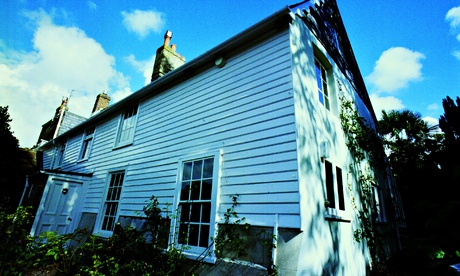
This week's poem, Virginia Woolf's Angels 1919, comes from Patricia McCarthy's new collection, Horses Between Our Legs, a collection which includes the poem that won first prize last year in the National Poetry Society competition, Clothes that escaped the Great War.
Set five years after the Battle of Mons, Virginia Woolf's Angels 1919 brings together in combat two distinct "Angel" myths, the "Angel in the House", and the Angel of Mons, to localise and dramatise a victory myth for Woolf herself.
The epigraph quotes a paper delivered in 1931 to the Women's Service League, Professions for Women later reprinted in The Death of the Moth and Other Essays. With a wonderful mixture of wit and high seriousness, Woolf explains how, in discovering herself as a writer, she found she had "to do battle with a certain kind of phantom … " which she named "after the heroine of a famous poem". This "famous poem" was The Angel in the House, Coventry Patmore's four-part, novel-sized exploration of married love, whose inventive approach to narrative might have impressed Woolf, in other circumstances. Instead, Patmore's "Angel" provides her with a powerful image of the repression of women. This icon of domestic virtue is a truly malignant figure, even though Woolf seems to demonstrate that she, Virginia Woolf, has little left to fear from such a phantom, when, playfully, triumphantly, she imagines her despatched by the symbolic throwing of an inkpot. The Angel does not only represent an imposed, male ideal of womanhood: she is the voice of internalised censorship. Women writers, Woolf declares, "must – to put it bluntly – tell lies if they are to succeed."
The "urban myth" of the Angel of Mons, said to have aided the British forces in that early battle of the first world war, has been described by the military historian Steve McGregor as "a masterly and enduring early example of disinformation and propaganda".
So both kinds of angel can represent distortion of the truth. Patricia McCarthy's poem, however, insists on their innocent literalness, and ingeniously re-imagines the battlefield angels as puckish, airy, dishevelled spirits of place in the first stanza, and, in the second, an ever-available inner resource. Outdoors, they hiss at the enemy, "with the sedge": indoors, they appropriately scupper its intrusion with "a swish/ Of wings dipped in ink … " This is war as intense psychic play.
1919 was the year in which the Woolfs bought a holiday house in the Sussex village of Rodmell, and Virginia published her second novel, Night and Day. How oppressive the war had been for Londoners emerges in the descriptions of air raids in her 1937 novel The Years.
Interestingly, the second stanza suggests that the armistice, and therefore the war, too, occurred "In the steep slopes of her temperament". The new mood of liberation seems embodied in the rolling, spacious, breezy South Downs landscape to which she now had easy access, and which McCarthy, local to the same area, so confidently evokes.
Flexible rhythms and rhyme patterns that are a melodic mix of full- and half-rhyme characterise the two sonnet-like stanzas. The first presents a light-hearted portrait of Woolf, surrounded by angels that "held up her skirts,/ Rode the rhythms of her walking feet … " They themselves have been healed ("Their wings no longer torn") and other redemptive powers are suggested by their watching "For ancient armies in retreat". The second stanza moves us on, with intimations, perhaps, of Woolf's descent into mental illness, as the angels become, like guardian angels, "her guides/ Through plankton, fossils, flint … " The last line seems comfortless; the writer's suicide is inevitably conjured by the image of the "sucking tides" and perhaps, too, intimations of the second world war in the white cliffs of the "precipices". Horatio's final words to Hamlet come to mind: "Good night, sweet prince:/ And flights of angels sing thee to thy rest." But such a thought may apply too much hindsight. The poem conveys many more of the "highs" of creativity than the "lows", and suggests the delight of a woman artist in a still-new century, defeating Victorian values and claiming her own, original literary vision.
Virginia Woolf's Angels 1919
"…whenever I felt the shadow of her wing or the radiance of her halo upon my page, I took up the inkpot and flung it at her. She died hard."
Virginia Woolf (re Coventry Patmore's The Angel in the House (Professions for Women, 1931)).
Five years after their rescue
Of troops beaten back in Mons,
She danced with them on the downs,
Their forms like kites she reeled in
With clouds, their haloes askew
On waves of green escarpments
Breaking into the sea. Beech-brown
The combes she looked down upon
While the angels held up her skirts,
Rode the rhythms of her walking feet –
Their wings no longer torn.
In a host they balanced, on the alert
For ancient armies in retreat
Squatting in hunched hawthorns.
One year after the armistice
In the steep slopes of her temperament
She kept them at her side, to banish
The simpering angels of the house
At whom, with the sedge, they would hiss.
Whenever an alien shadow bent
Over her page as she wrote, a swish
Of wings dipped in ink would douse
Its creeping insistence, despatch it
Into tumuli turfed over, into dew ponds.
The angels of Mons were her guides
Through plankton, fossils, flint; could fit
Into her psyche's darkest corners beyond
Precipices chalked in over sucking tides.

